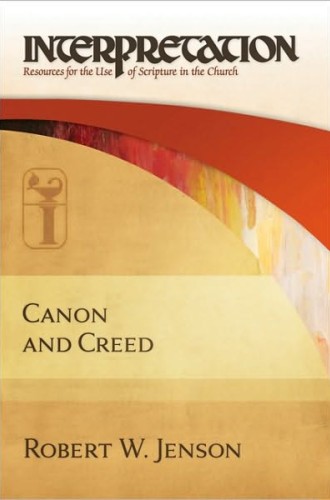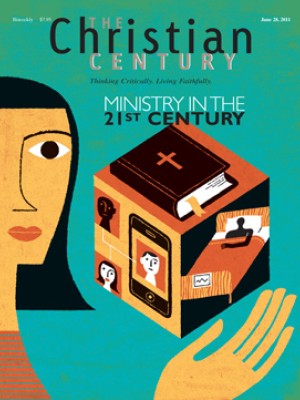Canon and Creed, by Robert W. Jenson
When Westminster John Knox Press launched the Interpretation commentary series in 1982 with Walter Brueggemann's provocative volume on the book of Genesis, readers encountered the strange new world of the Bible in a forgotten old form—something now frequently called theological interpretation, a way of reading the Bible that many in academic biblical scholarship at the time were endeavoring to leave behind. Three decades later, theological exegesis, though still a disputed discipline, is no longer a practice at the margins.
Broadly construed, the commentaries in the Interpretation series might all be considered examples of theological interpretation because they affirm a unified Christian canon rather than opting for an arbitrary division between a Hebrew Bible and a New Testament. The writers and editors intentionally situate each individual canonical book within a larger narrative of God's saving action in Christ, as proclaimed and lived out by the historic church. Each commentator thus struggles to make some sense of the Augustinian maxim that the New Testament is concealed in the Old and the Old Testament is revealed in the New.
Read our latest issue or browse back issues.
Robert Jenson's Canon and Creed is part of a second wave of volumes in the Interpretation series that aims to focus on vital themes for the preaching and teaching of scripture. Jenson, one of the most well-known and highly regarded contemporary Christian theologians, contributed to the first wave with a commentary on the Song of Songs. He now presents an account of theological interpretation that focuses on the mutuality of scripture and the creed (using the singular as shorthand to denote the historic creeds) of the church. On the basis of a reciprocal exchange between canon and creed, Jenson offers a modest proposal for ecumenical agreement: "The church is the community of a message, that the God of Israel has raised his servant Jesus from the dead." This, he argues, is a definitively Christian conviction. Jenson begins with a brief description of how the canon of scripture and the creed of the church developed together and a discussion of why neither one can be grasped without reference to the other. He suggests that the real question to struggle with is not "Why should the church adopt Israel's scripture?" but rather "Why does Israel's scripture need Jesus and his disciples?" He then examines how the rule of faith made it possible to understand the two Testaments as one canon and how the creed summarizes the trinitarian pattern of Christian scripture.
After three brief extensions on the canonical text, dogma and episcopacy, Jenson displays how the creed serves as a critical hermeneutical theory for reading scripture. Basic to such a strategy is learning to read with an eye to a "christological plain sense"—seeing, for example, the appearances of the Angel of the Lord in the Old Testament not merely as theophanies but as christophanies in which the second person of the Trinity appears in human form. In returning to the angelology of patristic exegesis, Jenson parts company with Karl Barth, who sharply distinguished between the Angel of the Lord and the Word incarnate in Jesus Christ, "who cannot be prefigured by any such being or set alongside it as a fulfillment."
Thankfully, Jenson does not simply lay out a theoretical account. He displays the creed-as-critical-theory by applying it to three texts: Genesis 1:1–5 (the creation), Luke 1:26–38 (the annunciation to Mary) and Mark 14:35–36 (the Gethsemane prayer). Reading texts in light of the fuller development of christological dogma, he believes, renders some difficult passages more intelligible. Such a case is the apparent conflict between Jesus' divine and human natures in the Gethsemane prayer—Jesus' decision is construed as "the Son's participation in the mutual triune deciding that is the divine will."
The application of the creed-as-critical-theory, Jenson contends, would be a decisive move given the current division between theology and biblical studies in the curricula of most Christian seminaries. The academy has long bought into a model in which biblical exegesis comes first and supplies the raw materials for theological reflection. According to this assumption, theological educators are heirs of modernity, which operated on the maxim that only what is true always and for everyone is a truth that can sustain life. On this count, Jenson concludes, modernity got it exactly backward. By reclaiming the perspective of the ancient church, he seeks to correct that mistake. His book, then, is a call to repair the modern breach between the canon of scripture and the creeds of the church so both may once again witness to the same Christ-centered truth of the gospel.
Jenson's proposal faces serious challenges, most obviously from the sort of biblical scholarship he seeks to overcome. Yet even sympathetic scripture scholars may worry that his exegesis attends too little to historical matters and perhaps a bit too much to theological concerns. Reading the Old Testament in light of the New is one thing, but applying the creeds ontologically so that the fullness of dogmatic teaching is imported retrospectively into the text is another. Free Church folk and evangelicals who have an aversion to creeds may similarly wonder whether appealing to creeds does much good. Whether Jenson's creed-as-critical-theory can achieve the hermeneutical purchase he hopes it will remains to be seen. But to dismiss the project as merely a call to return to a precritical exegetical past would be a mistake. This is a significant proposal that deserves serious attention






